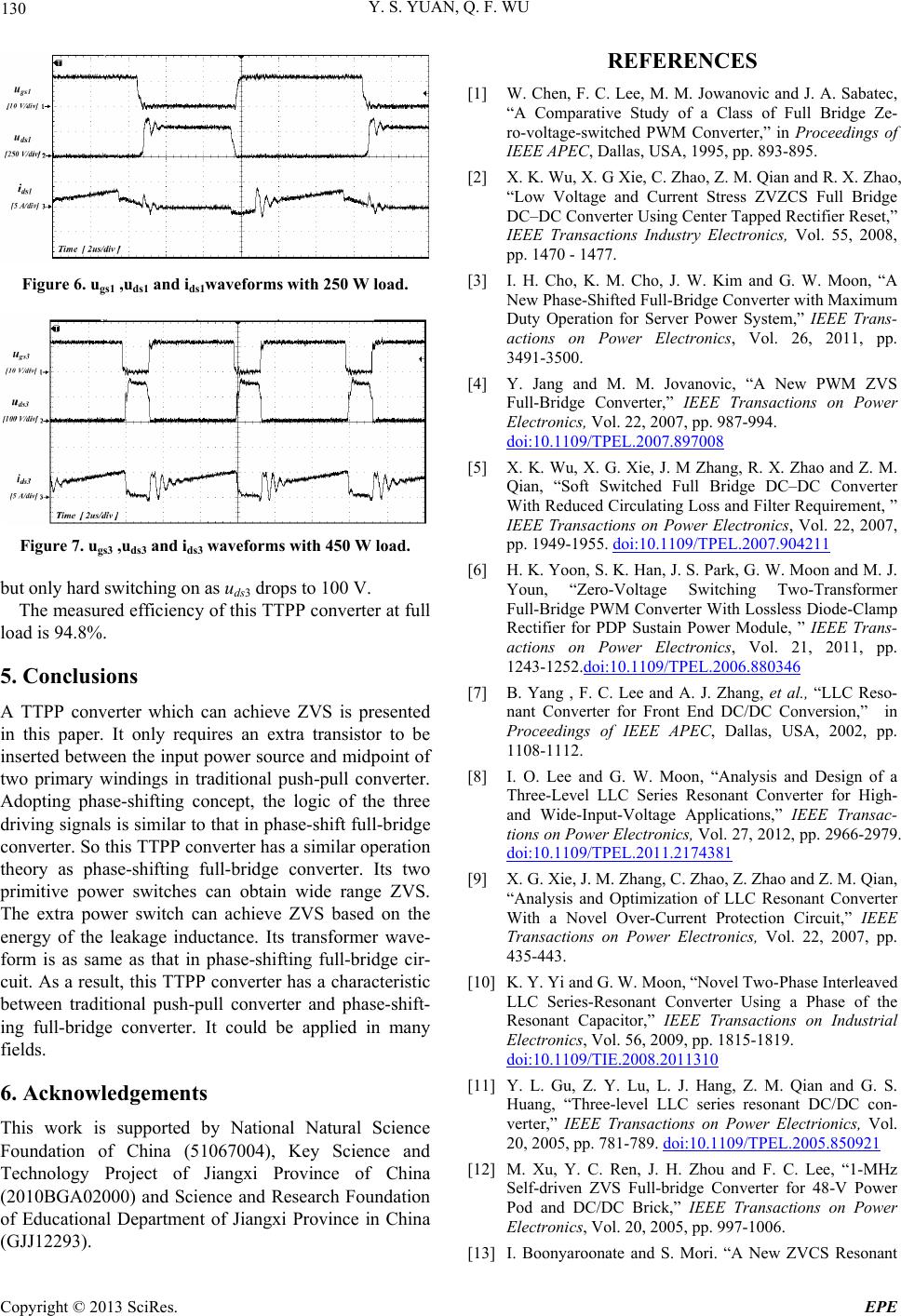
Y. S. YUAN, Q. F. WU
130
Figure 6. ugs1 ,uds1 and ids1waveforms w ith 250 W load.
Figure 7. ugs3 ,uds3 and ids3 waveforms with 450 W load.
but only hard switching on as uds3 drops to 100 V.
The measured efficiency of this TTPP converter at full
load is 94.8%.
5. Conclusions
A TTPP converter which can achieve ZVS is presented
in this paper. It only requires an extra transistor to be
inserted between the input power source and midpoint of
two primary windings in traditional push-pull converter.
Adopting phase-shifting concept, the logic of the three
driving signals is similar to that in phase-shift full-bridge
converter. So this TTPP converter has a similar operation
theory as phase-shifting full-bridge converter. Its two
primitive power switches can obtain wide range ZVS.
The extra power switch can achieve ZVS based on the
energy of the leakage inductance. Its transformer wave-
form is as same as that in phase-shifting full-bridge cir-
cuit. As a result, this TTPP converter has a characteristic
between traditional push-pull converter and phase-shift-
ing full-bridge converter. It could be applied in many
fields.
6. Acknowledgements
This work is supported by National Natural Science
Foundation of China (51067004), Key Science and
Technology Project of Jiangxi Province of China
(2010BGA02000) and Science and Research Foundation
of Educational Department of Jiangxi Province in China
(GJJ12293).
REFERENCES
[1] W. Chen, F. C. Lee, M. M. Jowanovic and J. A. Sabatec,
“A Comparative Study of a Class of Full Bridge Ze-
ro-voltage-switched PWM Converter,” in Proceedings of
IEEE APEC, Dallas, USA, 1995, pp. 893-895.
[2] X. K. Wu, X. G Xie, C. Zhao, Z. M. Qian and R. X. Zhao,
“Low Voltage and Current Stress ZVZCS Full Bridge
DC–DC Converter Using Center Tapped Rectifier Reset,”
IEEE Transactions Industry Electronics, Vol. 55, 2008,
pp. 1470 - 1477.
[3] I. H. Cho, K. M. Cho, J. W. Kim and G. W. Moon, “A
New Phase-Shifted Full-Bridge Converter with Maximum
Duty Operation for Server Power System,” IEEE Trans-
actions on Power Electronics, Vol. 26, 2011, pp.
3491-3500.
[4] Y. Jang and M. M. Jovanovic, “A New PWM ZVS
Full-Bridge Converter,” IEEE Transactions on Power
Electronics, Vol. 22, 2007, pp. 987-994.
doi:10.1109/TPEL.2007.897008
[5] X. K. Wu, X. G. Xie, J. M Zhang, R. X. Zhao and Z. M.
Qian, “Soft Switched Full Bridge DC–DC Converter
With Reduced Circulating Loss and Filter Requirement, ”
IEEE Transactions on Power Electronics, Vol. 22, 2007,
pp. 1949-1955. doi:10.1109/TPEL.2007.904211
[6] H. K. Yoon, S. K. Han, J. S. Park, G. W. Moon and M. J.
Youn, “Zero-Voltage Switching Two-Transformer
Full-Bridge PWM Converter With Lossless Diode-Clamp
Rectifier for PDP Sustain Power Module, ” IEEE Trans-
actions on Power Electronics, Vol. 21, 2011, pp.
1243-1252.doi:10.1109/TPEL.2006.880346
[7] B. Yang , F. C. Lee and A. J. Zhang, et al., “LLC Reso-
nant Converter for Front End DC/DC Conversion,” in
Proceedings of IEEE APEC, Dallas, USA, 2002, pp.
1108-1112.
[8] I. O. Lee and G. W. Moon, “Analysis and Design of a
Three-Level LLC Series Resonant Converter for High-
and Wide-Input-Voltage Applications,” IEEE Transac-
tions on Power Electronics, Vol. 27, 2012, pp. 2966-2979.
doi:10.1109/TPEL.2011.2174381
[9] X. G. Xie, J. M. Zhang, C. Zhao, Z. Zhao and Z. M. Qian,
“Analysis and Optimization of LLC Resonant Converter
With a Novel Over-Current Protection Circuit,” IEEE
Transactions on Power Electronics, Vol. 22, 2007, pp.
435-443.
[10] K. Y. Yi and G. W. Moon, “Novel Two-Phase Interleaved
LLC Series-Resonant Converter Using a Phase of the
Resonant Capacitor,” IEEE Transactions on Industrial
Electronics, Vol. 56, 2009, pp. 1815-1819.
doi:10.1109/TIE.2008.2011310
[11] Y. L. Gu, Z. Y. Lu, L. J. Hang, Z. M. Qian and G. S.
Huang, “Three-level LLC series resonant DC/DC con-
verter,” IEEE Transactions on Power Electrionics, Vol.
20, 2005, pp. 781-789. doi:10.1109/TPEL.2005.850921
[12] M. Xu, Y. C. Ren, J. H. Zhou and F. C. Lee, “1-MHz
Self-driven ZVS Full-bridge Converter for 48-V Power
Pod and DC/DC Brick,” IEEE Transactions on Power
Electronics, Vol. 20, 2005, pp. 997-1006.
[13] I. Boonyaroonate and S. Mori. “A New ZVCS Resonant
Copyright © 2013 SciRes. EPE